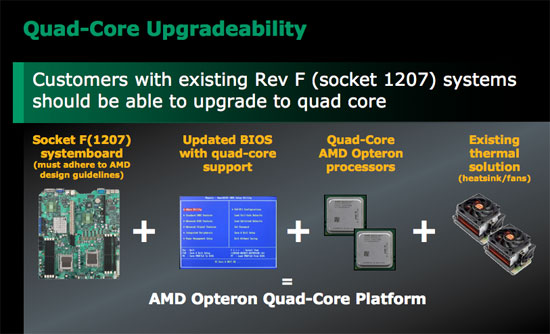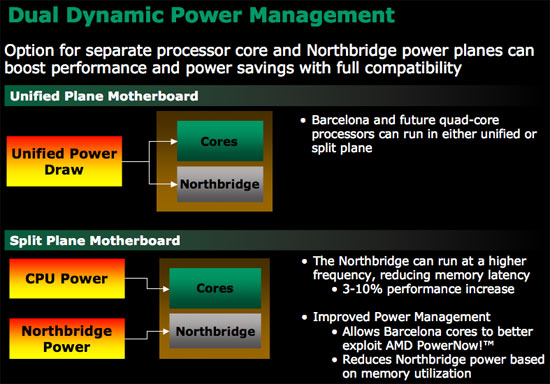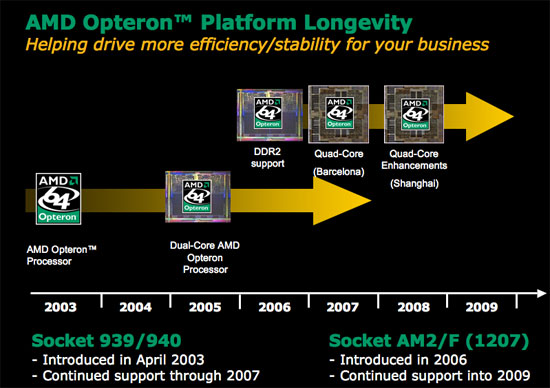New Details on Barcelona Emerge
If you've been following AMD's latest roadmaps then you'll know there are a couple of new sockets on the way. While AMD's next-generation CPUs will work in current Socket-AM2 and Socket-1207 motherboards, a new class of boards will launch with support for Socket-AM2+ and Socket-1207+. Inevitably the question you will ask yourself is: what does the + get you?
The pinout of Socket-AM2 and Socket-AM2+ is identical, and likewise Socket-1207 and 1207+, and thus the same Agena or Barcelona will work in both sockets, which is how AMD is able to guarantee full backwards compatibility with current AM2 and 1207 motherboards. If you do buy a new motherboard that uses either Socket-AM2+ or 1207+, you will get some additional functionality.

Current platforms only support HyperTransport 2.0, while the new + platforms will enable HT3.0 which brings faster link speeds and greater bandwidth. For desktops, a faster HT link won't really change performance, but in multi-socket workstations and servers there will be a benefit.

The more tangible feature is the ability to support split voltage planes. As we mentioned in our preview of AMD's Barcelona architecture, the CPU cores and the Northbridge can operate at different voltages and frequencies. In order to enable this functionality, you need motherboard support, thus if you want the power benefits of having the Northbridge and CPU cores on independent power planes you need an AM2+ or 1207+ motherboard.
It's not all about saving power with split voltage planes, as there's also a performance benefit to going AM2+/1207+. When the Northbridge is placed on its own power plane, the motherboard can actually apply more voltage to it than the CPU cores and run it at a slightly higher frequency on the order of a 200 - 400MHz increase. The Northbridge is an extremely low power part of the CPU die and an increase in voltage/clock frequency results in a minor increase in TDP, but it can drive a disproportionately large increase in performance.
With AM2+/1207+ systems, the Northbridge runs at a higher frequency and thus the memory controller sees slightly lower latencies. The shared L3 cache also operates on the same power plane as the Northbridge, reducing L3 cache latency as well. AMD expects the overall performance advantage by going with AM2+/1207+ to be on the order of 3 - 10% over current motherboards.

While your current motherboards will work with AMD's forthcoming CPUs, you'll get better performance out of upcoming Socket-AM2+ and Socket-1207+ platforms. AMD does plan on supporting both AM2 and 1207 into 2009, so you can expect a continued upgrade path for your AMD platforms well after Agena/Barcelona.
If you've been following AMD's latest roadmaps then you'll know there are a couple of new sockets on the way. While AMD's next-generation CPUs will work in current Socket-AM2 and Socket-1207 motherboards, a new class of boards will launch with support for Socket-AM2+ and Socket-1207+. Inevitably the question you will ask yourself is: what does the + get you?
The pinout of Socket-AM2 and Socket-AM2+ is identical, and likewise Socket-1207 and 1207+, and thus the same Agena or Barcelona will work in both sockets, which is how AMD is able to guarantee full backwards compatibility with current AM2 and 1207 motherboards. If you do buy a new motherboard that uses either Socket-AM2+ or 1207+, you will get some additional functionality.

Current platforms only support HyperTransport 2.0, while the new + platforms will enable HT3.0 which brings faster link speeds and greater bandwidth. For desktops, a faster HT link won't really change performance, but in multi-socket workstations and servers there will be a benefit.

The more tangible feature is the ability to support split voltage planes. As we mentioned in our preview of AMD's Barcelona architecture, the CPU cores and the Northbridge can operate at different voltages and frequencies. In order to enable this functionality, you need motherboard support, thus if you want the power benefits of having the Northbridge and CPU cores on independent power planes you need an AM2+ or 1207+ motherboard.
It's not all about saving power with split voltage planes, as there's also a performance benefit to going AM2+/1207+. When the Northbridge is placed on its own power plane, the motherboard can actually apply more voltage to it than the CPU cores and run it at a slightly higher frequency on the order of a 200 - 400MHz increase. The Northbridge is an extremely low power part of the CPU die and an increase in voltage/clock frequency results in a minor increase in TDP, but it can drive a disproportionately large increase in performance.
With AM2+/1207+ systems, the Northbridge runs at a higher frequency and thus the memory controller sees slightly lower latencies. The shared L3 cache also operates on the same power plane as the Northbridge, reducing L3 cache latency as well. AMD expects the overall performance advantage by going with AM2+/1207+ to be on the order of 3 - 10% over current motherboards.

While your current motherboards will work with AMD's forthcoming CPUs, you'll get better performance out of upcoming Socket-AM2+ and Socket-1207+ platforms. AMD does plan on supporting both AM2 and 1207 into 2009, so you can expect a continued upgrade path for your AMD platforms well after Agena/Barcelona.










55 Comments
View All Comments
tygrus - Saturday, May 12, 2007 - link
See latest low-power Athlon64 <10w idle. Can further reduce max power consumption (from 30-60w) if you limit the clock speed to about 1GHz and drop the voltage (<15w).TA152H - Sunday, May 13, 2007 - link
Tygrus,Idle isn't so important to me, getting to less than 1 watt idle isn't particularly hard if you go into sleep mode. You can't build a fanless, noiseless system based on idle performance. I was looking at Intel's ULV stuff too, but it's just not there either. It's kind of disappointing, because most people would be perfectly happy with a 1 GHz K6-III using 8 watts or less as it would on modern processes, and nothing like it is available. VIA's stuff sucks and I don't think is very efficient, even though they are targetting this market. My main machine I just upgraded to a Coppermine 600 on a weird Intel VC820 board. It's perfectly capable of doing just about everything I do, except for compiles (even a Core 2 is too slow for that, Microsoft seriously needs to work on parallelizing their compilers, or if they have recently, I need to buy it :P).
It's an enormous waste of electricity to sell these processors when the vast majority of people don't need them. To Microsoft's credit, they are always up to the challenge of releasing bloated software that requires more memory and processing power but is functionally the same, but at some point even their talent for this might run out.
While I was writing the first reply, I was lamenting about how lousy the current processors are in this respect, but then I read that at least AMD had a clue and said the Athlon design could not address this space and they had to go with something different. Maybe they'll bring the K6-III back, fix it's decoding/memory problems, and have a real winner. In terms of power/performance, there is just no beating it, these superpipelined processors are inherently poor at power use, and clearly have a performance bias. Why VIA went this way is a big mystery to me.
chucky2 - Friday, May 11, 2007 - link
If this article has accomplished one thing, it would be that we finally have confirmation that AM2+ CPU's will work in AM2 motherboards. Up to this point it's been people reporting on "sources" and stuff like that, nothing direct from AMD.Anand's report is more than good enough for me, I can finally rest easy that the PC I just built my cousin will have an upgrade path for at least another year down the road (if not two).
Thanks Anand and AMD! (and screw you Intel for you rediculously short upgrade paths!)
Chuck
AdamK47 - Friday, May 11, 2007 - link
Well played, Anand. Well played.Kiijibari - Friday, May 11, 2007 - link
I would have looked at my watch, while cinebench was running on the 4x4 system to get a rough estimate :)Not a correct result, but better than nothing.
Or was the system so fast, that cinebench was done after a few ns ^^ ? :)
Apart from that, nice article, thanks :)
cheers
Kiijibari
Anand Lal Shimpi - Friday, May 11, 2007 - link
I counted seconds in my head, out of fairness to AMD I didn't report the number I calculated :)Take care,
Anand
Sunrise089 - Friday, May 11, 2007 - link
Didn't you guys notice the huge disconnect between the excitement evident in Anand's text and the fairly small ammount of new info? I think it should be obvious that AMD revlealed a lot more, but they have put various NDA dates on when the info can be released. So I would say they did open up a lot, but that we will only see the new info become available as we get closer to Barcelona.Anand Lal Shimpi - Friday, May 11, 2007 - link
I think you have to shift your expectations a bit; going into this thing I wanted to see Barcelona performance, I wanted the equivalent of what Intel did with Penryn and Nehalem. I didn't get that, but what I did get was a much clearer understanding of AMD's direction for the future. The section on Fusion is of particular importance to the future of the company, it just so happens that AMD's strategy is in line with Intel's, lending credibility to what it is doing.Then there were a handful of Barcelona tidbits that I needed to stick in some sort of an article, so this one just seemed the best venue to do so. More information is coming though, stay tuned for next week. No benchmarks yet unfortunately :(
Take care,
Anand
Stablecannon - Friday, May 11, 2007 - link
Wonderful. So basically this article was an AMD morale booster.
"Hey this Phil Hester, just wanted to say don't lose faith in us, even though we don;t have anything to show you really...that's because it's a secret. Yeah, that's it. We actually have a 16 core chip running at 3.8 that'll cream Intel. What's that? You want to see it? LOL."
TA152H - Friday, May 11, 2007 - link
First of all, I read the part about AMD becoming much more forthcoming with information, and then saw essentially nothing new in the article. Pretty much all of this stuff is known, and the important stuff you still don't know. So, how are they so much more open again? I didn't see it.Actually, I would have been disappointed if they were. I mean, you can scream about how they're not giving you what YOU want, but it's all about what they want. I don't buy them giving information out too early for Intel, you can be pretty sure there are plenty of companies designing products around AMD's new chip and you can be pretty sure at least one person has "slipped" and told Intel something. It's more likely it's not to AMD's benefit to have people knowing it's so much better than what's out now. How do they move product they are making today when people are waiting for their next great product? It's just common sense, they don't care if people whine about lack of visibility, too much is worse than too little. They have given out some numbers, and they are very high, so I doubt they're too concerned about performance. I think they're more concerned about selling stuff they have out today, which they aren't doing a great job of. What would happen if they showed a great product right around the corner? Q1 would look like a success compared to what they'd endure.
When you talk about Phil Hester you have to realize this guy referred the 8088 an eight-bit architecture (so he was not referring to the data bus). After that, I don't know what to think about what he says.
Next, the reason the 287 didn't sell was because it seriously sucked! It was worse than the 8087 because it didn't even run synchronously with the processor. Considering the 286 was way more powerful than the 8086/8088, there was a perfectly good reason why no one wanted a math coprocessor that was expensive, generally ran at 2/3 CPU speed (unless a seperate crystal was put in for it, which was done with later 286 machines), and actually had less performance than the 8087. The 387 was much more powerful and totally redesigned.
Also keep in mind the 486 was later made in an incarnation called the 486SX, that had either a disabled or no math coprocessor on it.
Saying the Cell is before it's time is implying it's fundamentally a useful product, but other things around it have to catch up. That's wrong and misleading. It's a niche product and it's a bear to program and is terrible in most things besides what it was designed for. Time won't change it, unless they change the Cell. The way it is now, it'll never be anything more than a niche product, nor was it designed to be more than that.
For their < 1 watt processors, it might be interesting to see if they bother with a decoupled architecture. My guess is they'll just run x86 instructions natively, without wasting so much silicon on the decoders.
With regards to AMD's next processor taking so long, I think it's even worse when one considers the K8 isn't really a K8 at all, it's more like a K7+. It's very similar to the K7, and is far less of a jump than the Prescott was from the Northwood. It's more like the Pentium MMX was to the Pentium (I'm not talking about the MMX instructions, there was a lot more changes than that).
The remarks about AMD coming back from this stronger than ever are absurd and ridiculous. They can come back, and they certainly have a good product in the wings, but it's got nothing to do with losing $611 million. It weakened the company, plain and simple, although not irrevocably. They had to slow down their investment and conversion, which isn't good. They had to sell $2 Billion in debts at very disadvantageous terms. Both of these are injuries that will have longer term ramifications for the company. So, yes, they aren't dead, but saying this will make them stronger in the long run is plain wrong and equally weird.